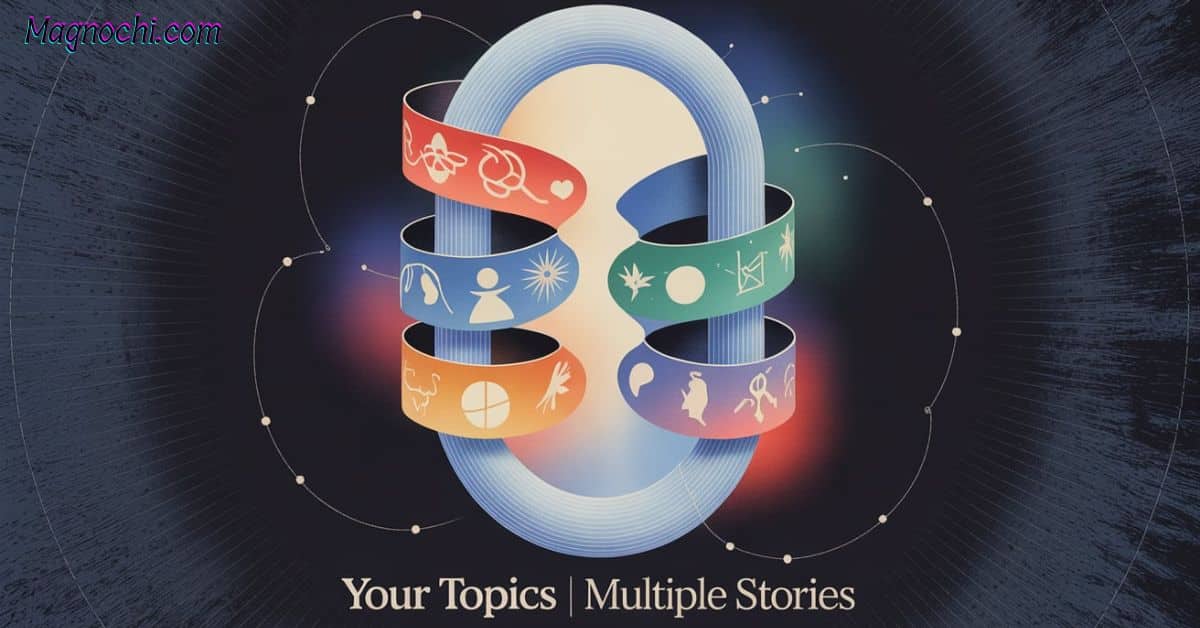Storytelling has always shaped how humans connect, remember, and share knowledge. But today, a single storyline feels too narrow.
With audiences exposed to global events, cultural perspectives, and digital platforms, one-dimensional narratives fall short. Instead, we’ve entered a new era of narrative diversity, where multi-threaded narratives, layered storytelling, and interactive formats reveal deeper truths.
This shift is often called “your topics | multiple stories.” It’s not just a buzzword. It’s a recognition that complex issues like climate change, mental health, or AI in healthcare cannot be told through one voice alone.
They require narrative multiplicity: stories woven from data, emotion, culture, and lived experience.
Why Narrative Diversity Matters
Modern readers want more than facts. They seek perspectives in storytelling that reflect reality’s complexity.
When you only tell one angle, you miss the richness of human experience. Multiple storylines don’t just broaden understanding; they increase reader engagement by offering entry points for different audience archetypes.
Psychological Impact of Multi-Perspective Storytelling
- Empathy: Hearing a farmer in Kenya discuss drought makes climate change personal.
- Retention: Story layering helps audiences remember complex issues better than raw data alone.
- Relatability: When teenagers in Cape Town describe water scarcity, global audiences feel the urgency differently than when reading statistics.
Technology and Globalization Fueling Change
- Social media platforms amplify user-generated media, forcing traditional outlets like The Guardian and The New York Times to adopt multimedia storytelling.
- Audiences in Austin, Hutto, TX, and across the United States consume the same story differently than audiences in Germany or Israel, pushing content creators to build narrative ecosystems with sub-narratives for cultural resonance.
Layers of Perspective in Storytelling
Cultural Narrative Divergence
Cultural context shapes every story. For example:
- Kenya: Stories about climate change often highlight farmers’ survival.
- Germany: Coverage may focus on climate tech innovations and industrial policy.
- U.S.: Media often emphasizes the sociopolitical divide in climate policy.
Emotional vs Analytical Lenses
- Emotional lens: Victims’ families sharing grief in a Netflix crime documentary.
- Analytical lens: Journalists dissecting justice system narratives and policy changes.
Together, these create a surface layer of empathy and a data layer of facts.
Generational Perspectives
- Gen Z: Engages with interactive content and 3D content experiences.
- Millennials: Favor podcasts and mental wellness apps for health narratives.
- Boomers: Still prefer in-depth features in outlets like The New York Times.
Story Layering: Depth Beyond the Surface
Story layering takes a topic beyond one arc. Each layer adds meaning:
| Layer | Definition | Example |
|---|---|---|
| Surface layer | Immediate facts or visible storyline | Water shortage in Flint, Michigan |
| Data layer | Research, stats, analytics | Depression rates analysis in U.S. teens |
| Human layer | Personal anecdotes, lived experiences | Doctors’ testimonials on AI in medicine |
| Speculative layer | Future implications, predictions | Future health systems shaped by AI |
This approach transforms content consumption. Readers no longer skim headlines they immerse themselves in multi-dimensional experiences.
Industry Adoption and Transformation
Streaming Platforms: The Netflix Effect
Netflix pioneered multi-threaded narratives with shows like Crime documentaries. They mix victims’ families stories, justice system narratives, and aftermath coverage into layered arcs. This format created higher public reaction and long-lasting audience engagement.
News and Media
- The Guardian uses multimedia storytelling, combining video, data visuals, and human stories in climate change narratives.
- The New York Times blends interactive content, like urban transportation challenges maps, with editorial essays.
Brands and Marketing
Businesses and marketers adopt format diversity blogs, podcasts, short videos to build narrative ecosystems. Instead of one ad campaign, brands now design sub-narratives targeting different audience archetypes.
Case Studies: Narrative Multiplicity in Action
Global Water Crisis
- Core topic: Scarcity of clean water.
- Sub-narratives:
- Water activist campaigns in Kenya.
- Teenager perspective in Cape Town on daily shortages.
- Policy debates in the United States after the Flint, Michigan water crisis.
- Desalination technology in Israel as a speculative solution.
This narrative multiplicity blends science, human impact, and tech innovation.
AI in Healthcare
- Surface layer: News on AI-powered diagnostics.
- Data layer: Historical evolution of AI in medicine with adoption timelines.
- Human layer: Patient case studies describing improved treatments.
- Speculative layer: Ethical debates in AI and the impact on future health systems.
Cultural Entertainment Example: Marvel Multiverse
The Marvel multiverse demonstrates how story layering and multi-threaded narratives create reader engagement across decades. Each film is a sub-narrative yet part of one narrative ecosystem.
Creating Your Own Narrative Ecosystem
Define the Core Topic
Choose one strong theme: climate change, mental health storytelling, or AI in healthcare.
Map Sub-Narratives
List out perspectives:
- Emotional vs analytical lenses
- Cultural narrative divergence
- Audience archetypes (teenagers, professionals, policymakers)
Use Format Diversity
Mix formats for content strategy:
- Blogs for thought leadership
- Podcasts for therapy experiences
- Short videos for mental wellness apps promotion
- User-generated media for authentic voices
Build Narrative Bridges
Connect the arcs. A story on depression rates can bridge into therapy experiences and then into mental wellness apps.
Measure Reader Engagement
Track what resonates: dwell time, shares, digital audience engagement across platforms. Use analytics to refine your content strategy.
The Future of Multi-Story Narratives
AI and Interactive Media
- AI will personalize multimedia storytelling, offering users tailored sub-narratives.
- Interactive content and 3D content experience will let readers step inside stories, not just read them.
Audience as Co-Creators
User-generated media will drive your topics | multiple stories further. Readers don’t just consume; they shape story outcomes.
Predictions
- Businesses and content creators will prioritize SEO content strategy with layered storytelling.
- Newsrooms will evolve into narrative ecosystems, where each piece is one part of a wider puzzle.
- Future health systems and climate tech innovations will be told through sub-narratives blending science, ethics, and human stories.
Conclusion
We’ve entered a new era of narrative diversity, where no single voice can define truth. The rise of multi-threaded narratives and story layering makes issues richer, more relatable, and unforgettable.
Whether you’re covering the global water crisis, exploring AI in healthcare, or analyzing mental health storytelling, the key is to create your topics | multiple stories approach.
By building narrative ecosystems, leveraging format diversity, and weaving narrative bridges, content creators, marketers, and businesses can transform audience understanding.
The result? Reader engagement that lasts because people don’t just consume stories anymore, they live inside them.
FAQs
What does “your topics | multiple stories” mean in modern storytelling?
It’s a storytelling approach that uses narrative diversity and multi-threaded narratives to show different perspectives. Instead of one viewpoint, it layers cultural, emotional, analytical, and future-focused angles to give a complete picture.
How can brands use “your topics | multiple stories” for better audience engagement?
Brands can build a narrative ecosystem with sub-narratives tailored to different audience archetypes. By mixing format diversity like podcasts, blogs, videos, and interactive content they create narrative bridges that connect with readers on multiple levels.
Why is “your topics | multiple stories” the future of content strategy?
Because audiences expect depth and participation. With multimedia storytelling, user-generated media, and even 3D content experiences, this model makes stories more immersive. It boosts reader engagement and keeps content relevant in a noisy digital world.
Read more knowledgeable blogs on Magnochi









